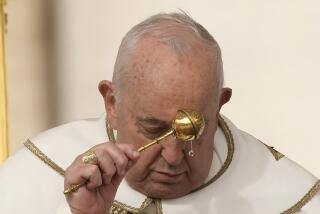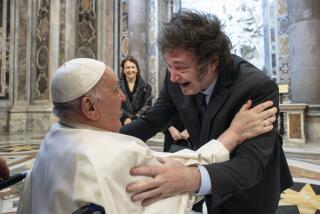Pope Benedict XVI ends Latin visit with call for freedoms in Cuba
HAVANA — Pope Benedict XVI on Wednesday concluded his first trip to the Spanish-speaking Americas, launched with a condemnation of Marxism and drug war violence and ending with a forceful plea for “genuine freedom” as he preached from the symbolic heart of Cuba’s leftist revolution.
Standing under larger-than-life portraits of revolutionary heroes such as Che Guevara, the pope admonished Cuban authorities for not doing enough to allow the public exercise of religious faith. Later, he met with former President Fidel Castro, and the two octogenarians joked about the hardships of being old men.
Dressed in a gilded miter and robes of purple in keeping with the Lenten season, Benedict rode the popemobile into the Plaza of the Revolution and presided over an open-air Mass witnessed by an estimated 300,000 Cubans and other Latin Americans. The event was broadcast on state television and radio.
PHOTOS: Pope Benedict XVI visits Havana
“It must be said with joy that in Cuba steps have been taken to enable the church to carry out her essential mission of expressing her faith openly and publicly,” the pope said in the homily, which he read in Spanish.
“Nonetheless, this must continue forward, and I wish to encourage the country’s government authorities to strengthen what has already been achieved and advance along this path of genuine service to the true good of Cuban society as a whole.”
He specifically asked that Catholic teaching be allowed in schools. Currently, the church is allowed to instruct only adults.
“The right to freedom of religion, both in its private and in its public dimension, manifests the unity of the human person, who is at once a citizen and a believer,” the pope said.
“Cuba and the world need change, but this will occur only if each one is in a position to seek the truth and chooses the way of love, sowing reconciliation and fraternity.”
On the plaza, a giant altar built for the occasion was surrounded by fluttering Cuban and yellow-and-white Vatican flags.
The only outwardly religious adornment was a billboard-sized banner with an image of Our Lady of Charity, patron saint of Cuba, hanging on the side of the National Library.
Some worshipers had traveled by bus all night across the island nation, arriving at dawn for the 9 a.m. Mass, a sweltering, sunbaked affair despite the morning hour. Some people took shelter under umbrellas. A number succumbed to the heat, carried off on Red Cross stretchers.
Many praised the pope’s call for an expanded role for the Roman Catholic Church, noting that Cuba had witnessed baby steps toward more religious freedom in recent years as relations with the church have warmed.
“The church should be given more freedom — freedom not to paint things in a way they’re not, but to paint things as they are,” said a 17-year-old student named Jose Miguel, who declined to give his last name. “The church could help the state a lot.”
The teenager said Cubans needed the right to think and express themselves, including considering alternatives to the island’s communist rulers. “There’s desire, but a lot of fear,” he said.
William Ramirez, 53, who works for a company that builds theatrical stages, said Cuba had achieved a “middle stage” of change since Pope John Paul II’s groundbreaking 1998 visit, with plenty of room remaining to improve religious freedom.
“The message arrived,” Ramirez said, gesturing toward Benedict. “We have to keep working on his message.”
Ana Isabel Hernandez, 46, a church worker who traveled 10 hours by bus from Villa Clara in central Cuba, applauded Benedict’s call for more religious liberty.
“This is what everybody in Cuba was hoping for,” she gushed afterward. “A bit more freedom, maybe.”
Although the crowd was mostly Catholics, the Mass drew many nonbelievers eager to catch a glimpse of the pope, or just to take part in a big event.
“Look around. Most people here aren’t believers,” said Maria Gomez, a 48-year-old schoolteacher and nonbeliever. “People came for, I don’t know, curiosity. To join the excitement.”
Church attendance in Cuba is the lowest in the region, though a vast majority has expressed belief in the divine. Especially as the gains of the 53-year-old revolution fade, more Cubans are turning to religion in search of hope and comfort.
Though subtle, the pope’s message was clearly aimed at Cuban authorities. President Raul Castro greeted the pope warmly but said the regime was already “changing everything that needed to be changed,” and Vice President Marino Murillo made it clear that reform would be economic, not political.
Seemingly underscoring that point, dissidents by the dozens were rounded up before the pope’s arrival and, during his stay, their phones were disconnected and homes surrounded, human rights organizations said Wednesday.
To what extent the pope and Fidel Castro touched on these themes in their half-hour meeting was unclear. Benedict, who turns 85 next month, and Castro, already 85, shared a cordial chat about books and age. “I’m very old but I can still do my job,” the pope said.
Later, as Benedict departed Havana to head back to Rome, he appeared to criticize the U.S. embargo on Cuba, saying that restrictions are worsened by “economic measures, imposed from outside the country” that “unfairly burden” the people.
PHOTOS: Pope Benedict XVI visits Havana
Times staff writer Tracy Wilkinson in Mexico City contributed to this report.
More to Read
Start your day right
Sign up for Essential California for news, features and recommendations from the L.A. Times and beyond in your inbox six days a week.
You may occasionally receive promotional content from the Los Angeles Times.






